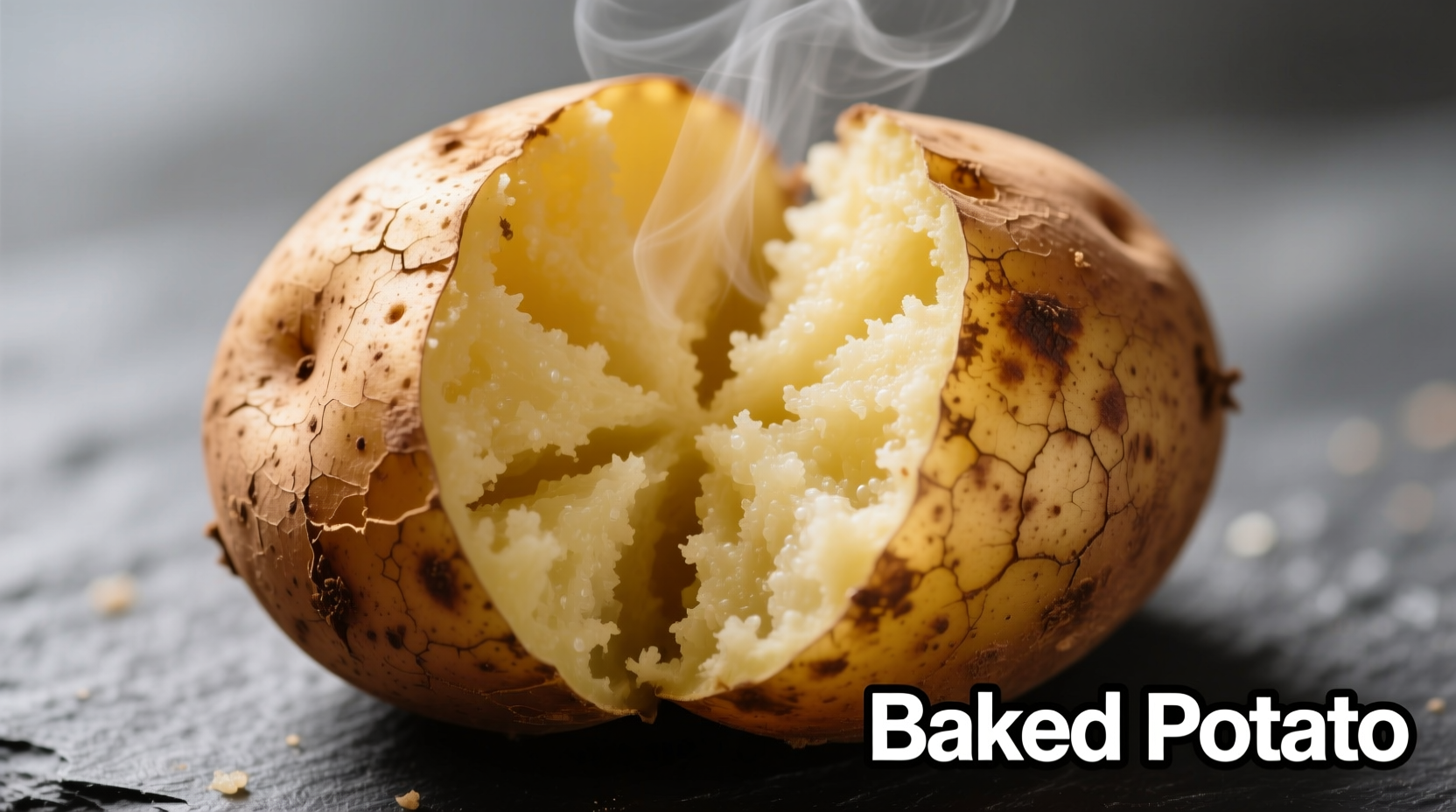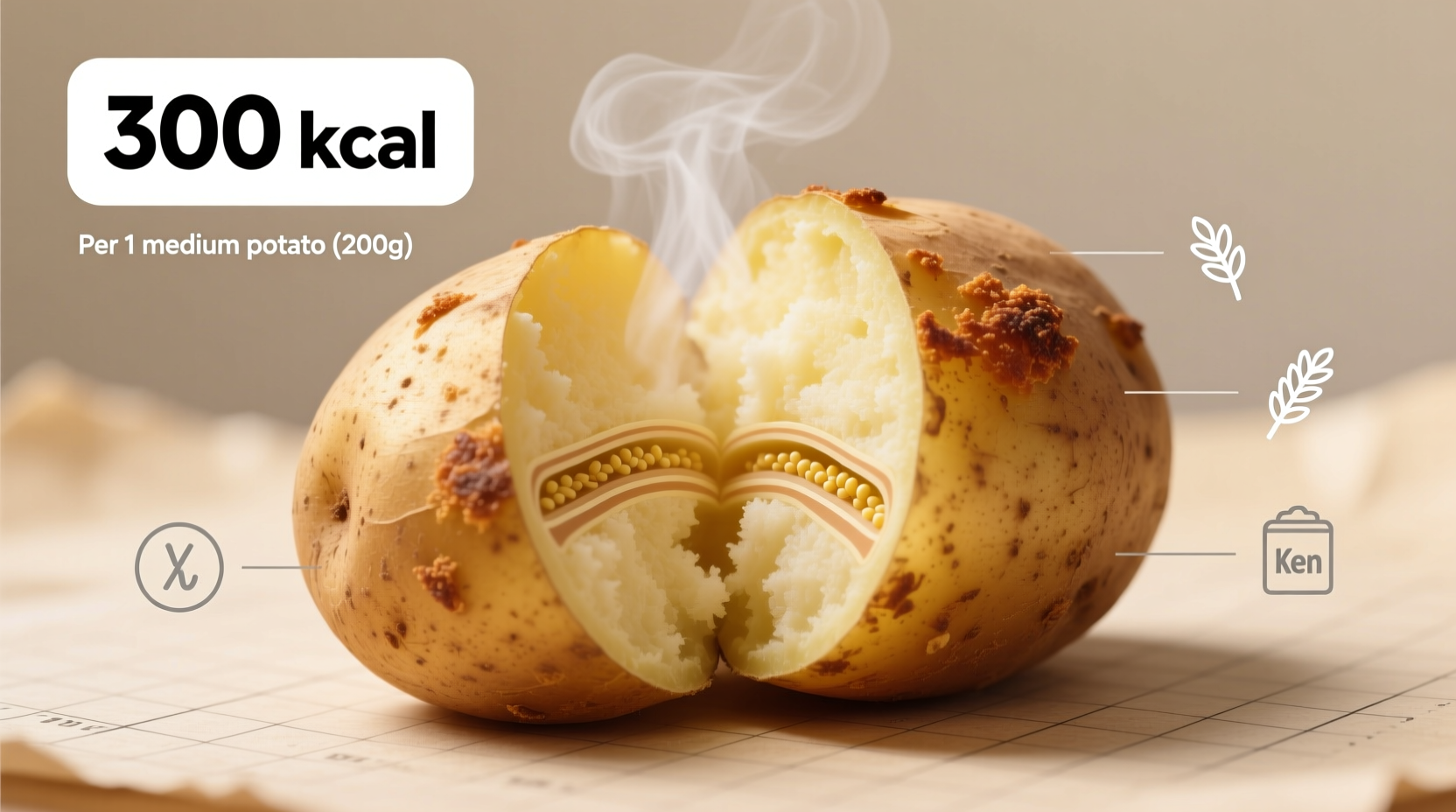A medium-sized baked potato (about 150g or 5.3 oz) with skin contains approximately 161 calories. The exact count varies based on size: small (130g) has 129 calories, medium (150g) has 161 calories, and large (250g) has 275 calories. Adding common toppings like butter, sour cream, or cheese significantly increases the calorie count.
Understanding the precise calorie content of baked potatoes helps you make informed dietary choices without sacrificing flavor or satisfaction. Whether you're managing your weight, tracking macros, or simply curious about this versatile staple, knowing exactly what you're consuming puts you in control of your nutrition.
Breaking Down Baked Potato Calories by Size
Portion size dramatically affects the calorie count in baked potatoes. The USDA FoodData Central provides standardized measurements that help eliminate guesswork when tracking your intake. Here's the precise calorie breakdown based on official nutritional data:
| Size Category | Weight (grams) | Calories | Carbohydrates | Protein |
|---|---|---|---|---|
| Small | 130g | 129 | 29g | 2.9g |
| Medium | 150g | 161 | 37g | 4.3g |
| Large | 250g | 275 | 63g | 7.2g |
| Extra Large | 369g | 368 | 84g | 9.5g |
This data comes directly from the USDA FoodData Central database, the most authoritative source for nutritional information in the United States. Notice how the nutritional profile remains consistent per gram, but total values scale with portion size.
How Preparation Affects Calorie Content
What many people don't realize is that how you prepare your baked potato significantly impacts its nutritional profile. Consider these critical factors:
- Skin on vs. skin off: Keeping the skin adds fiber and nutrients with minimal calorie increase. A medium potato with skin has 161 calories, while without skin it drops to about 145 calories.
- Cooking method: True baking (dry heat in oven) preserves the natural calorie count, while methods that add fat increase calories substantially.
- Cooling effect: Allowing your baked potato to cool after cooking increases resistant starch content, which has fewer available calories and provides additional gut health benefits.
According to research published in the Journal of Nutrition and Metabolism, cooling cooked potatoes for 24 hours can increase resistant starch content by up to 70%, potentially reducing the effective calorie count by 10-15% as some carbohydrates become indigestible.
Baked Potato vs. Other Potato Preparations
When tracking calories, understanding how different potato preparations compare helps you make smarter choices. Here's how baked potatoes stack up against common alternatives:
- Baked potato (medium, plain): 161 calories
- Mashed potatoes (1 cup): 237 calories (often higher due to added milk and butter)
- French fries (medium serving): 365 calories
- Hash browns (1 cup): 193 calories
- Roasted potatoes (1 cup): 169 calories (can be higher with oil)
The Centers for Disease Control and Prevention notes that preparation method is often more important than the food itself when managing calorie intake. Baking without added fats makes potatoes one of the most calorie-efficient ways to enjoy this nutrient-dense vegetable.
Nutritional Benefits Beyond Calories
While calorie count matters, focusing solely on calories misses the bigger nutritional picture. A medium baked potato delivers impressive nutritional value:
- 45% of your daily vitamin C needs
- 26% of your daily potassium requirement
- 20% of your daily vitamin B6
- 12% of your daily fiber needs (with skin)
- Negligible fat content (0.2g in a medium potato)
Registered dietitians increasingly recognize potatoes as a valuable component of balanced diets. The 2020-2025 Dietary Guidelines for Americans specifically includes potatoes in the vegetable group, noting they provide essential nutrients often under-consumed in American diets.

Smart Topping Strategies for Calorie Control
The real calorie challenge with baked potatoes comes from toppings. A plain potato is relatively low-calorie, but popular additions can transform it into a high-calorie meal. Consider these smarter alternatives:
| Traditional Topping | Calories (per serving) | Lower-Calorie Alternative | Calories (alternative) |
|---|---|---|---|
| 2 tbsp butter | 200 | 1 tbsp olive oil | 120 |
| 2 tbsp sour cream | 56 | 2 tbsp Greek yogurt | 26 |
| 1/4 cup shredded cheese | 110 | 2 tbsp nutritional yeast | 25 |
| 2 tbsp bacon bits | 25 | 1 tbsp smoked paprika | 6 |
Dietary research shows that strategic topping choices can reduce the total calorie count of a loaded baked potato by up to 60% while maintaining satisfaction. The key is focusing on flavor intensity rather than volume—small amounts of intensely flavored ingredients often satisfy more than larger portions of milder toppings.
Practical Applications for Different Dietary Goals
Understanding how to incorporate baked potatoes into various eating patterns makes this information truly valuable:
- Weight management: Enjoy a medium baked potato (161 calories) as your carbohydrate source with lean protein and non-starchy vegetables for a balanced 400-500 calorie meal.
- Post-workout recovery: Pair a medium baked potato with skin (excellent source of potassium) with grilled chicken for optimal muscle recovery.
- Diabetes management: Combine smaller portions (100g or 108 calories) with healthy fats and protein to moderate blood sugar response.
- Meal prep: Bake multiple potatoes at once, then store in the refrigerator for quick meals throughout the week—cooling increases resistant starch content.
Nutrition professionals emphasize that context matters more than isolated numbers. As noted by the Academy of Nutrition and Dietetics, "Foods shouldn't be labeled 'good' or 'bad' based on calorie count alone. Consider the overall nutritional package and how it fits within your total dietary pattern."
Common Misconceptions About Potato Calories
Several myths persist about potatoes and calories that deserve clarification:
- Myth: Potatoes are high glycemic and should be avoided for weight loss.
Fact: While potatoes have a high glycemic index, the glycemic load (which considers typical portion size) is moderate. Cooling potatoes reduces their glycemic impact. - Myth: Sweet potatoes are always lower in calories than white potatoes.
Fact: A medium sweet potato (130g) contains 112 calories compared to 129 in a small white potato—differences are minimal. - Myth: Potatoes cause weight gain.
Fact: Research published in the British Journal of Nutrition found no association between potato consumption and weight gain when prepared without added fats.
These clarifications help separate evidence-based nutrition from popular misinformation, allowing you to make informed decisions about including potatoes in your diet.
Putting It All Together: Your Baked Potato Action Plan
Now that you understand the calorie facts and nutritional context, here's how to apply this knowledge immediately:
- Measure your potato before baking to accurately track calories
- Always bake with skin on for maximum nutrients and fiber
- Cool potatoes after cooking to increase resistant starch
- Use flavorful, low-calorie toppings like herbs, spices, and vinegar
- Pair with protein and non-starchy vegetables for balanced meals
- Consider portion size based on your specific dietary goals
By following these simple steps, you can enjoy the satisfying taste and texture of baked potatoes while staying within your calorie goals. Remember that food tracking apps often misrepresent potato calories—using the USDA standards provided here ensures accuracy in your nutritional tracking.
Frequently Asked Questions
How many calories are in a baked potato without skin?
A medium baked potato (150g) without skin contains approximately 145 calories, compared to 161 calories with skin. While removing the skin reduces calories slightly, you also lose valuable fiber and nutrients concentrated in and just beneath the skin.
Do baked potatoes have more calories than boiled potatoes?
No, the cooking method itself doesn't change the calorie content significantly. A medium potato has about 161 calories whether baked or boiled. However, baked potatoes often have less water content, making them slightly more calorie-dense by weight. The main difference comes from what you add after cooking.
Are baked potatoes good for weight loss?
Yes, when prepared properly. A plain baked potato is relatively low in calories, high in fiber and nutrients, and very filling. The key is controlling portion size and avoiding high-calorie toppings. Studies show that potatoes rank high on the satiety index, meaning they help you feel full longer than many other carbohydrate sources.
How does cooling affect baked potato calories?
Cooling baked potatoes increases their resistant starch content, which is not fully digested and therefore provides fewer available calories. Research suggests cooled potatoes may deliver 10-15% fewer net calories than when eaten hot, while also providing additional gut health benefits.
What's the healthiest way to eat a baked potato?
The healthiest approach is to bake with skin on, cool slightly, and top with nutrient-dense, low-calorie options like Greek yogurt, herbs, spices, or a small amount of olive oil. Pair with lean protein and non-starchy vegetables for a balanced meal that maximizes nutritional benefits while controlling calories.











 浙公网安备
33010002000092号
浙公网安备
33010002000092号 浙B2-20120091-4
浙B2-20120091-4